Predicting the effects of climate change on alpine rock slopes: Evaluation of paraglacial and periglacial drivers of rockfall in the European Alps (ALPINE ROCK SLOPES, 2016 – 2019)
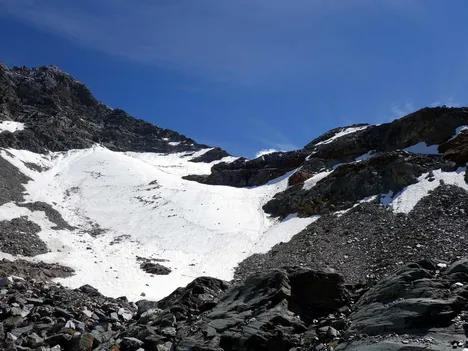
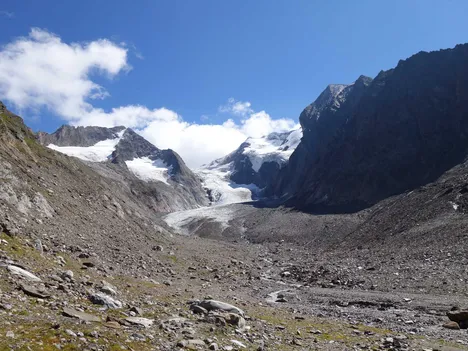
Rockfall from alpine rockwalls represents a hazard to human life and infrastructure but also a natural process of rock slope evolution. Two contrasting hypotheses currently exist which aim to explain rock slope evolution: (1) a paraglacial adjustment of the rockwalls with increasing frequency due to deglaciation and a subsequent asymptotically decline of adaption and (2) a frost-weathering dominant adaption with steady-state rates. Climate change will affect alpine systems by an increase of temperatures and a decrease of frost weathering activity and glaciated area. Hypothesis (1) suggests an increase of rockfall frequency due to deglaciation. On contrary, hypothesis (2) expects a decrease of rockfall frequency due to the dislocation of highest frost cracking activity to higher altitudes. Both hypotheses are based on assumptions which have been never tested or validated in the field. As a consequence, the future adaption of rockwall to climate change is unknown. Very few studies focus on rockfall after deglaciation on different time scales. On the Holocene time scale, rockfall is relied to increase post glaciation. The findings are based on dating and derivation of erosion rates without incorporating mechanical or thermal rockwall properties. As a result, the observed increase cannot be traced back to paraglacial adjustment or frost weathering processes. On the contrary, rock slope erosion in recently deglaciating areas can integrate mechanical and thermal rockwall properties. However, the period to establish frequency-distributions is too short to draw conclusions on potential evolution due to climate change. This approach integrates Holocene and recent rock slope erosion in one investigation. The objectives of the study are (1) to quantify the thermal regime of the rockwalls, (2) to quantify the response of mechanical regime and establish a short-term erosion rate. Furthermore, the study will (3) increase the process understanding of frost weathering and (4) quantify long-term rock slope erosion. In a space-for-time substitution approach (5) a rock slope erosion model will be developed to bridge short-term and long-term rock slope failure. Fieldwork will take place in the Hungerli Valley, Valais Alps, and in the Gaisberg Valley, Ötztal Alps. State-of-the-art geomorphological, geotechnical and geophysical methods including refraction seismic tomography, electric resistivity tomography, terrestrial laserscanning, laboratory frost-weathering simulation and Be-10 dating will be combined to address the research objectives. Expected results include the temporal and spatial distribution of permafrost and frost weathering processes, the short-term adaption of rockwalls, an increase of understanding of frost weathering processes, a frost weathering model, a rock slope erosion model bridging short- and long-term rock slope erosion and the prediction of future rock slope evolution in the context of climate change and increased deglaciation.
Funding: German Research Foundation (DFG)
Amount of Funding: ~360 k€
Contributing People:
- Daniel Draebing (PI, Lead, Technische Universität München)
- Michael Krautblatter (CO, TU München)
- Miriam Dühnforth (CO, LMU München)
- Samuel T. McColl (CO, Massey Univesity, Palmerston North, New Zealand)
- Tristram C. Hales (CO, Cardiff University, United Kingdom)
- David Morche (CO, Universität Halle)
Steep permafrost slopes in Norway (CryoWALL, 2015 – 2019)
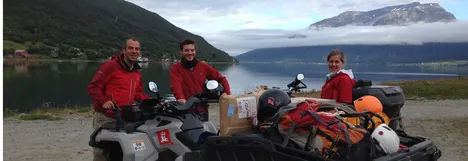
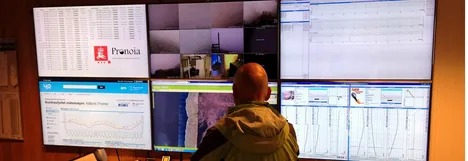
The stability of steep slopes and rock walls is a major point of concern in relation to a changing climate, and is important for society, transport and more. Permafrost is a factor which can stabilize steep sloops. Rock wall permafrost has been intensively investigated in mountain areas like the Alps, but there is little knowledge about the topic in Norway. CryoWALL aims to investigate permafrost on rock walls in Norway. The stability of steep slopes and rock walls is a major point of concern in relation to a changing climate, and important for society, transport and more. It is well known that permafrost can be a major factor for the stability of steep slopes, covered either with debris or in rock walls. In Norway we find permafrost widespread all over the country. Many steep rock walls lie in the mountain permafrost zone, and in Jotunheimen monitoring of rock wall temperatures documents this fact. In northern Norway, permafrost is attributed to be a major cause for the deformation pattern of a steep rock slope, which is a large threat if failure occurs. In the past decade, many thousand rock fall or slide events were recorded which affected the national road network and transport infrastructure, and many of those might originated from steep slopes underlain by permafrost. Cryowall will evaluate the spatial distribution of steep permafrost rock walls in Norway, instrument selected sites of special interest both in southern and northern Norway, and help addressing risk areas by employing empirical and physical rockfall run out models from selected site. We will install rock wall temperature loggers, and use these data to model the thermal regime in rock walls depending on climate forcing and snow conditions. We will employ stability modelling of selected rock falls, along with laboratory testing of rock samples at the TU Munich, Germany. Rock fall and rockslides have happened also earlier during the Holocene, and to understand future responses of permafrost in rock walls, it is important to address former conditions. We will therefore use advanced dating techniques to evaluate the development of slip planes in permafrost rock walls.
Funding: The Research Council of Norway
Amount of Funding: ~690 k€ (TU part: ~680 kNKr (ca. 70 k€))
Contributing People:
- Bernd Etzelmüller (PI, Lead, University of Oslo, Norway)
- Michael Krautblatter (PI, Technische Universität München)
- Benjamin Jacobs (PI, Technische Universität München)
- Sebastian Westermann (PI, University of Oslo, Norway)
- Kristin Sæterdal Myhra (PI, University of Oslo, Norway)
- Reginald Hermanns (PI, Norwegian Geological Survey, Norway)
- Paula Hilger (PI, Norwegian Geological Survey, Norway)
- Jan Otto Larsen (PI, Statens Vegvesen, Norway)
- Ketil Isaksen (PI, Norwegian Meteorological Institute, Norway)
Influences of snow cover on thermal and mechanical processes in steep permafrost rock walls (ISPR 2011 – 2015)
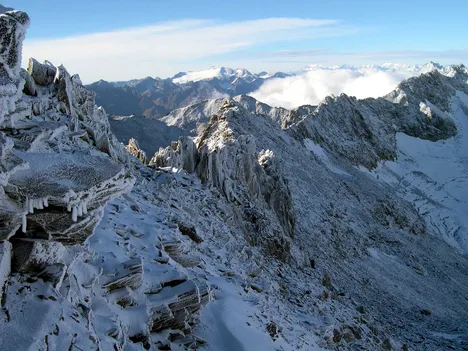
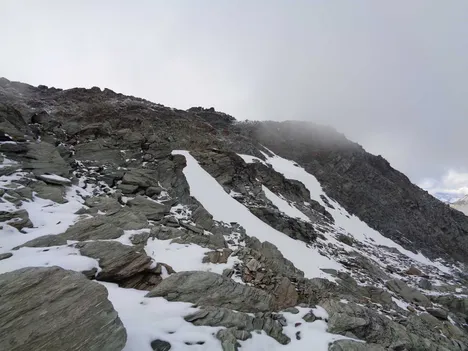
In this project, the influence of snow cover on thermal and mechanical processes in steep permafrost rockwalls was systematically researched. (1) Snow distribution is controlled by micro-topographical factors. Increasing slope angle does not decrease snow depth, however, snow distribution is more heterogeneously in steeper terrain. Furthermore, snow deposition show similar patterns of snow depth and distribution from year to year with maximum depth between 1.5 and 2 m at Gemsstock and up to 3.8 m at Steintaelli. In addition, snow ablation is influenced by local shading effect which can reverse the usual earlier ablation on the south-exposed slopes. (2) The timing, initial thickness and duration of the snow cover strongly influence the thermal regime of rockwalls. At both research areas, a cooling effect by late snow cover onset and long-term insulation and a warming effect by early snow cover onset were observed. The insulation by snow cover is influenced by snow cover properties and started at a threshold of 0.2 m where snow depth becomes the major factor controlling the thermal regime. (3) To address spatial and temporal variation of active-layer, we developed a novel laboratory-calibrated SRT approach. The approach was combined with thermal data from borehole and temperature modelling and demonstrated that the cooling effect of a long lasting snow cover preserves frozen conditions or decreases active layer thaw while areas of the earlier snow disappearance show much deeper active or permafrost absence. (4) The mechanical regime strongly reflects the snow cover and the thermal. During snow-free periods, high frequency thermal expansion and contraction occurred which can be amplified by volumetric expansion when temperature drops below -10°. In contrast, insulating snow prevents thermal expansion or contraction and favours ice segregation. Basal ice layer formation prevents snowmelt infiltration into open joints in spring and, thus, prevents the development of perched groundwater levels. In addition, ice filling in fractures is required to prevent water seepage from fractures and hydrostatic pressure development. Rock fractures show an oscillating behaviour without persistent crack opening is observed, however, high-frequent high-magnitude thermal expansion and contraction and low frequent high-magnitude ice segregation can lead to rock fatigue which reduces long-term rock stability. (5) We united our findings into a rock-ice mechanical model and a conceptual model to explain the influence of snow cover on thermal and mechanical processes in permafrost rockwalls. On seasonal scale, snow cover controls the timing of rock instabilities which can occur during two time windows of instability in summer and autumn. On a long-term scale, rock bridge cracking due to ice segregation and or thermal stress can change system state from rock-mechanical to more sensitive ice-mechanical state. Increased active-layer thaw due to enhanced warming by climate change can further increase sensitivity to failure.
Part 1: internal response (German Working Group)
Part 2: external forcing (Swiss Working Group)
Funding: German Research Foundation (DFG) and Swiss National Fund (SNF)
Amount of Funding: ~400 k€ (TU part: 200 k€)
Contributing People:
- Michael Krautblatter (Main applicant Part 1, Lead, Technische Universität München)
- Richard Dikau (Co-applicant Part 1, PhD supervisor, University of Bonn)
- Daniel Draebing (PhD student Part 1, University of Bonn, now TUM)
- Hailiang Jia (guest PhD student, University of Wuhan, China)
- Marcia Phillips (Main applicant Part2, Swiss project leader, SLF Davos)
- Martin Hoelzle (Co-applicant Part 2, University of Fribourg)
- Stephan Gruber (Co-applicant Part 2, Carlton University)
- Anna Haberkorn (PhD Student Part 2, SLF Davos, University of Fribourg)
- Robert Kenner (technical assistant Part 2, SLF Davos)
- Hansueli Rhyner (technical assistant Part 2, SLF Davos)
Key Publications:
- Draebing, D., Haberkorn, A., Krautblatter, M., Kenner, R.and M. Phillips (accepted): Thermal and mechanical responses resulting from spatial and temporal snow cover variability in permafrost rock slopes. Submitted to Permafrost and Periglacial Processes.
- Draebing, D. (2016): Application of Refraction Seismics in Permafrost Studies: A review. Earth Science Reviews 155: 136-152. https://dx.doi.org/10.1016/j.earscirev.2016.02.006
- Phillips, M., Haberkorn, A., Draebing, D., Krautblatter, M., Rhyner, H. and R. Kenner (2016): Seasonally intermittent water flow through fractures in a rock ridge: Gemsstock, central Swiss Alps. Cold Regions Science and Technology 125: 117-127. https://dx.doi.org/10.1016/j.coldregions.2016.02.010
- Krautblatter, M. and K. Leith (2015): Glacier- and permafrost-related slope instabilities. In: C. Huggel, M. Carey, J.J. Clague, A. Kääb (Eds.): The High-Mountain Cryosphere. Cambridge University Press, Cambridge, 147-165.
- Jia, H., W. Xiang, and M. Krautblatter (2015): Quantifying rock fatigue and decreasing compressive and tensile strength after repeated freeze-thaw cycles. Permafrost and Periglacial Processes 26(4), 368-377. https://dx.doi.org/10.1002/ppp.1857
- Draebing, D., Krautblatter, M. and R. Dikau (2014): Interaction of thermal and mechanical processes in steep permafrost rock walls: a conceptual approach. Geomorphology 266:226-235. https://dx.doi.org/10.1016/j.geomorph.2014.08.009
- Krautblatter, M. and D. Draebing (2014): Pseudo 3D – P-wave refraction seismic monitoring of permafrost in steep unstable bedrock. Journal of Geophysical Research – Earth Surface 119 (2): 287-299. https://dx.doi.org/10.1002/2012JF002638
- Krautblatter, M., Funk, D. and F.K. Günzel (2013): Why permafrost rocks become unstable: a rock–ice-mechanical model in time and space. Earth Surface Processes and Landforms 38(8), 876-887. https://dx.doi.org/10.1002/esp.3374
- Draebing, D. and M. Krautblatter (2012): P-wave velocity changes in freezing hard low-porosity rocks: a laboratory-based time-average model. The Cryosphere 6:1163-1174. https://dx.doi.org/10.5194/tc-6-1163-2012
Monitoring potential hazardous rock walls and slopes in mountain regions (MOREXPERT, 2010-2017)

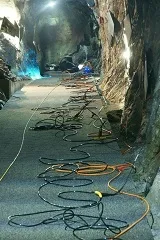
MOREXPERT investigates short and medium term responses of slope stability to climatic changes in high alpine rock walls. The study contributes to the question how man and infrastructure at risk are potentially affected by these responses. Based on a combination of geophysical and geotechnical methods, surface and subsurface conditions are monitored within the study area at Kitzsteinhorn (3.204m), Hohe Tauern. Factors controlling slope stability in steep bedrock, most notably freeze/thaw and permafrost dynamics, are identified and analyzed with respect to changing climatic conditions. The fundamental goal of MOREXPERT is to develop a general decision-support-system (DSS) for slope stability assessment in steep bedrock. Due to its flexible structure the DSS is intended to be adaptable for the application in rock walls of other regions.
Funding: Austrian Research Promotion Agency (FFG)
Amount of Funding: ~1,000 k€ for 8 scientific partners
Contributing People:
- Ingo Hartmeyer (Lead, Alp-S)
- Markus Keuschnig (PI, Alp-S)
- Robert Delleske (PI, Alp-S)
- Paul Dobesberger (PI, Alp-S)
- Clemens Hiller (PI, Alp-S)
- Michael Krautblatter (PI, Technische Universität München)
- Lothar Schrott (PI, Universität Bonn)
- Jan-Christoph Otto (Universität Salzburg)
- Bernhard Niedermoser (PI, ZAMG - Zentralanstalt für Meteorologie und Geodynamik)
Key Publications:
Keuschnig, M., Krautblatter, M., Hartmeyer, I., Fuss, C. and L. Schrott (2016): Automated Electrical Resistivity Tomography Testing for Early Warning in Unstable Permafrost Rock Walls Around Alpine Infrastructure. Permafrost and Periglacial Processes. https://dx.doi.org/10.1002/ppp.1916
Sensitivity of rock permafrost to climate change and implications for rock instability (SORP, 2008-2011)
In this project we developed two geophysical monitoring techniques, electrical resistivity tomography and seismic refraction tomography, that can monitor the spatial extend of frozen rock (i.e. permafrost) in rock faces in meters to tens of meters depth. Thawing permafrost rapidly decreases rock and ice-mechanical strength of rock material and presently heavily affects dozen of cables cars and infrastructure facilities in the Alps and other high mountain systems. In the example above, permafrost degradation spatially and temporally corresponds with highest rates of rock displacement (extensometers) along the crestline. With the developed methods we can investigate permafrost close to infrastructure within days up to a few decameters depth and can monitor changes daily.
Funding: German Research Foundation (DFG)
Amount of Funding:
Contributing People:
- Richard Dikau (Lead, University of Bonn)
- Michael Krautblatter (PI, University of Bonn)
- Sarah Verleysdonk (PhD, University of Bonn)
Key Publications:
- Verleysdonk, S., Krautblatter, M. & Dikau, R. (2011): Sensitivity and path dependence of mountain permafrost systems. Geografiska Annaler, Series A, Vol 93: 113-135. https://dx.doi.org/10.1111/j.1468-0459.2011.00423.x
- Krautblatter, M., Verleysdonk, S., Flores-Orozco, A. & Kemna, A. (2010). Temperature-calibrated imaging of seasonal changes in permafrost rock walls by quantitative electrical resistivity tomography (Zugspitze, German/Austrian Alps). Journal of Geophysical Research - Earth Surface. https://dx.doi.org/10.1029/2008JF001209
- Krautblatter, M. (2010): Patterns of multiannual aggradation of permafrost in rock walls with and without hydraulic interconnectivity (Steintälli, Valley of Zermatt, Swiss Alps). Lecture Notes in Earth Sciences. Vol. 115: 199-214. https://dx.doi.org/10.1007/978-3-540-75761-0_13
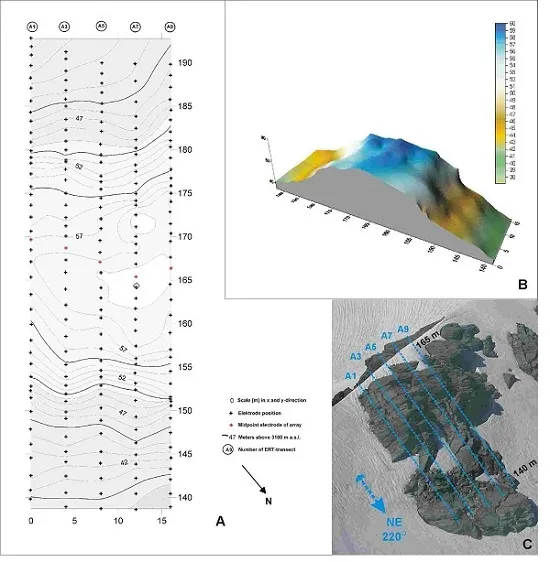
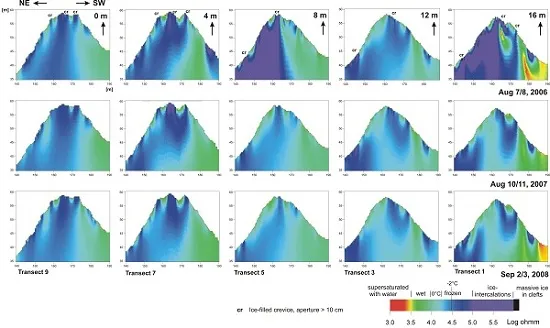
Research Projects - shortlist
| 12/2012-12/2018 | "Assessing, Monitoring, Geophysical Reconnaissance and Modelling of slope instability above a hydropower structure" - 3 project periods Funding: E.ON / Uniper GmbH
|
| 2016-2019 | "Predicting the effects of climate change on alpine rock slopes: Evaluation of paraglacial and periglacial drivers of rockfall in the European Alps (ALPINE ROCK SLOPES)" Funding: German Research Foundation (DFG)
|
| 04/2016-04/2020 | “Debris-flow modeling and sediment budget monitoring near Oberstdorf (Bavaria, Germany)" Funding: Bavarian Environmental Ministry
|
| 12/2015-02/2016 | “Assessing, Geophysical Reconnaissance and Modelling of slope instability above a hydropower structure Mühltal." Funding: E.ON (hydropower)
|
| 11/2015-05/2017 | “Real time monitoring of fracture initiation in natural stones induced by environmental stresses (StoneMon)” Funding: Deutsche Bundesstiftung Umwelt (DBU, German Environmental Foundation)
|
| 07/2015-06/2018 | "CryoWall – Permafrost rock walls in Norway" Funding: The Research Council of Norway
|
| 06/2014-05/2017 | "Georisks in a changing climate, Landslide hazard assessment in the Bavarian Pre-Alps" Funding: Bavarian Environmental Ministry
|
| 07/2013-06/2014 | ESA-Project: “Assessment of slow permafrost-controlled Alpine landslides using differential SAR interferometry over two decades” in cooperation with Dr. S. Plank |
| 08/2011-09/2011 | Cooperation project (09/2011) Japanese Southern and Northern Alps, Permafrost site at the Fujiyama. Funding: 7 k€ (own share)
|
| 09/2011-03/2015 | Principal applicant in “ISPR: Influences of snow cover on thermal and mechanical processes in steep permafrost rock walls.” D-A-CH (SNF/DFG) proposal, with Dr. M. Phillips (SLF), Prof. M. Hölzle (Fribourg) and Dr. S. Gruber (Zurich). 2 Ph.D. 75%-positions for 36 months. |
| 11/2010-11/2011 | Co-applicant in TRANSAFROST: Critical Thermo-Hydro-Mechanical Transitions in thawing permafrost rocks and soils. Funding: DFG research group initiation funding of the ABCJ (Geozentrum Aachen Bonn Köln Jülich) Amount of Funding: 60 k€
|
| 05/2010-11/2012 | Co-applicant in "Carbon release from degrading permafrost in the western Canadian Arctic". Funding: BMBF
|
| 10/2010-01/2012 | Scientific partner in “Monitoring the thermal state of permafrost by automated time-lapse Capacitive Resistivity Imaging”. Funding: NERC/UK
|
| 09/2010-10/2010 | Principal Applicant in “1st Mid-European Summerschool on Geomorphology: Complex Response of Earth Surface Processes to Environmental Change”. Funding: Volkswagen Foundation. |
| 04/2010-03/2017 | Co-applicant in “Monitoring potential hazardous rock walls and slopes in mountain regions (MOREXPERT)”. Funding: K2-competence center of Austrian Research Promotion Agency (FFG). |
| 08/2009-09/2011 | Co-applicant in “Dangerous lakes - Hazard assessment and outburst flood estimation of naturally dammed lakes in Central Asia”. Funding: Volkswagenstiftung
|
| 08/2008-08/2011 | Scientifc design and authoring of “Sensitivity of Rock Permafrost to Climate change (SORP)” in the DFG Bundle-Project „Sensitivity of Permafrost to Climate Change (SPCC)". main applicant Prof. R. Dikau. (University of Bonn) |
| 06/2005-10/2007 | Scientific partner in the Public-Private Partnership “SensorGIS” with Terrestris, TÜV Rheinland, Schütz GmbH, Scatterweb to develop an expert system for remote monitoring of slope instability. |
| 04/2005-04/2008 | Student on Position C7: Permafrost Research Training Group Landform, Studies. University of Bonn, Institute of Geography Funding: German Research Foundation (DFG)
Key Publications:
|
| 02/2005-05/2005 | Research Invitation, Rock breakdown laboratory, U. of Oxford (Prof. H.A. Viles): Nonlinear dynamics of weathering in response to climatic fluctuations; test site Nant Ffrancon, North Wales. |